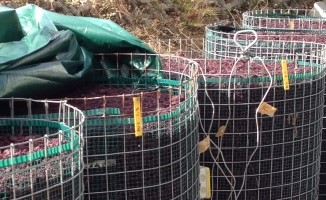
Valorization of new high added value compounds from European vine and wine production solid wastes
Grapes are the world’s second largest fruit crop. European countries are the most important producers, essentially for winemaking. Waste valorization becomes a matter of strategic and economic importance to increase the rate of recycling. The extraction yield of bio-active compounds is influenced mainly by the process of extraction. The traditional extraction technique employs solvents. The aim of the project is the valorization of the grape solid wastes with green processes to produce high added value compounds. New processes such as pulsed electric fields, subcritical water extraction and membranes increase the extraction of the valuable products. The main goals are: feasibility of the processes; best set parameters to optimize the extraction yield of compounds; treatment protocols of practical use for the industry; impact of the treatment on the product quality; use of the molecules in wine industry; cost, environmental, economic and social analysis for implementing the treatment stage compared with traditional extraction methods.
The objective of Changins was to optimize the storage conditions of red grape pomaces, particularly for polyphenol preservation, under conditions that are available in an industrial context. The conservation must be possible over a 6 month period, should be convenient, economic and ecologically acceptable.
The storage of pomaces under optimum conditions is essential to preserve the quality of the compounds present in pomaces, such as tannins and anthocyanins. The pomaces are not chemically stable; they contain ethanol, sugars, acids, tannins, anthocyanins, yeasts and bacteria. The storage of pomaces at ambient temperature with an exposition to oxygen (aerobic conditions) may induce reactions, such as acetic acid formation, oxidation, and development of moulds. These transformations can reduce the quality of the compounds and the extraction yield. For example, the oxidation reduces the quality of tannins and anthocyanins; the growth of moulds may reduce the quality and the quantity of tannins; the production of acetic acid in the pomaces reduces the extraction yield.
In an industrial process, pomaces need to be transported and stored before polyphenol extraction. The treatments tested in this project, have been selected for their applicability in an industrial process and for their accessibility in different winery type/size. Another major selection criteria was that the treatments should minimize the energy consumption.
The storage of small samples (1 kg) and therefore of larger size samples (700 l) was tested in different conditions: ambient temperature or cooled (4°C), anaerobic (saturation with N2) or aerobic, with or without addition of sulphur dioxide (SO2), outdoor or indoor. The results showed that SO2 did not improve polyphenol stability. The cooling at 4°C under anaerobic atmosphere were the best conditions to preserve polyphenols (quantity and quality) but costly at industrial scale. An ambient temperature under aerobic atmosphere was not suitable for the conservation of polyphenols and an ambient temperature under anaerobic conditions offered a good polyphenol preservation with limited oxidation.
Upscaling of volume without inerting did not provide good enough anaerobic conditions to preserve the polyphenols and the color even in the core of the heap. The best results for the preservation of polyphenol was the storage O2.
An assessment of waste production in Swiss wine production has be done. The yearly production of red grapes is around 60’000 to and the pomaces production is around 7’000 to (fresh weight, without stems), with 5 to of skins and 2 to of grape seeds.
The pruned shoot are also a potential source of valuable molecules. The Swiss legislation requires that the shoots returned to the vineyard. The effect of the harvest of pruned shoots on the level of organic matter has been evaluated. A four year experimentation was done in Prangins. No significant differences on the amount of organic matter between the plots with or without restitution of shoots. A Rock-Eval analysis was done on different vineyards in Canton de Vaud and in the experimentation in Prangins. No differences on the quantity and the quality of organic matter could be observed in the comparable crops. Generally the organic matter had a low degree of humification. The University of applied Sciences Changins will go on with this experimentation five years more.
Plus d’informations sont disponibles dans le site internet officiel du projet : www.valuxtract.univ-bordeauxsegalen.fr
Valorisation
MIETTON-PEUCHOT M., YAMMINE S., BURDET J.-P., JUNG R., VOROBIEV E., TURK M. and MANTEAU S. 2014. Valorization of New High Added Value Compounds from European vine and wine production solid wastes – technological, economical and social issues. Transnational joint calls for boosting eco-innovation, Mid-Term meeting of first call, Tuesday 16 afternoon, Copenhagen, Danemark.
2012 – 2017
Partenaires: projet européen Eco-Innovera (Université Bordeaux Segalen Unité de Recherche Œnologie (France), Université de Technologie de Compiègne Génie des Procédés (France), Hochschule Geisenheim University (Allemagne), SOFRALAB (France), ESCOM (France))
Financement de la partie effectuée par Changins: Office fédéral de l’environnement (OFEV)
